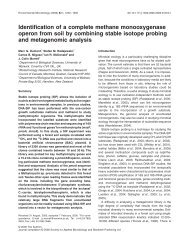Conservation of the vaquita Phocoena sinus - The Department of ...
Conservation of the vaquita Phocoena sinus - The Department of ...
Conservation of the vaquita Phocoena sinus - The Department of ...
Create successful ePaper yourself
Turn your PDF publications into a flip-book with our unique Google optimized e-Paper software.
210 L. Rojas-Bracho, R. R. Reeves and A. Jaramillo-Legorreta<br />
RECOMMENDATIONS<br />
Scientific<br />
At this stage, <strong>the</strong> <strong>vaquita</strong>’s survival does not depend on more or better science. Ra<strong>the</strong>r, what<br />
is needed now is political will combined with more imagination on <strong>the</strong> part <strong>of</strong> environmental<br />
activists, conservation strategists and decision-makers at all levels <strong>of</strong> government. Also, it is<br />
essential to maintain <strong>the</strong> role <strong>of</strong> <strong>the</strong> international scientific community in supporting Mexico<br />
with technical advice and moral encouragement. Any funds available in <strong>the</strong> near future for<br />
ano<strong>the</strong>r abundance survey or even for a new bycatch estimate would be better spent on<br />
improved management and on evaluating <strong>the</strong> effectiveness <strong>of</strong> management measures.<br />
One scientific problem that has not been addressed to date concerns <strong>the</strong> natural history<br />
and phenology <strong>of</strong> blue shrimp. According to an experienced trawler captain (J. Osuna,<br />
personal communication), <strong>the</strong>se shrimp, as <strong>the</strong>y mature, move south and away from <strong>the</strong> core<br />
area <strong>of</strong> <strong>vaquita</strong> distribution. If this were shown to be true, it might mean that larger shrimp<br />
are available to be fished in areas where <strong>the</strong> conflict with <strong>vaquita</strong>s is less acute, or perhaps<br />
even non-existent. Unless it has already been addressed through studies with which we are<br />
not familiar, this question should be pursued through research.<br />
Socio-economic<br />
<strong>The</strong> challenge <strong>of</strong> achieving socio-economic change that will benefit <strong>the</strong> <strong>vaquita</strong> without<br />
disrupting <strong>the</strong> lives <strong>of</strong> large numbers <strong>of</strong> people cannot be overstated. Socio-economic alternatives<br />
need to be both financially viable and sustainable in <strong>the</strong> medium and long terms.<br />
Considerations that need to be taken into account include <strong>the</strong> following:<br />
• A goal must be to create attractive economic alternatives for fishermen and to keep <strong>the</strong>m<br />
economically productive.<br />
• Strategies rooted in paternalistic attitudes towards fishermen have failed in many parts <strong>of</strong><br />
<strong>the</strong> world, and it is important to avoid paternalistic approaches, e.g. simply paying fishermen<br />
to abandon fishing. Fishermen need to be consulted at every stage and <strong>the</strong>ir perspectives<br />
represented in any decision-making framework.<br />
• Economic alternatives should be capable <strong>of</strong> providing fishermen with incomes similar to<br />
those gained from fishing. However, it is unlikely (at least in a Mexican context) that a market<br />
economy without subsidies can create such employment opportunities. Although subsidization<br />
will certainly be necessary, phase-out <strong>of</strong> subsidies should be built into any long-term<br />
strategy.<br />
• Even if new types <strong>of</strong> employment can be made available, <strong>the</strong>re is no guarantee that<br />
fishermen will be inclined or able to take advantage <strong>of</strong> <strong>the</strong>m. <strong>The</strong>refore, any job-creation<br />
initiative must be accompanied by appropriate training and skills development.<br />
• Any strategy for socio-economic change (e.g. job creation) will require direct, coordinated<br />
involvement by a number <strong>of</strong> players, ideally including federal, state and local government<br />
authorities, business groups and non-governmental organizations.<br />
• No strategy is likely to succeed without buy-in from <strong>the</strong> local community. That is, <strong>the</strong><br />
fishermen and <strong>the</strong>ir families must be made to feel that <strong>the</strong>ir views and interests have been<br />
respected, and that <strong>the</strong>y stand to benefit (or at least not be harmed) from any change in <strong>the</strong><br />
status quo.<br />
• Puerto Peñasco, like San Felipe, has a sufficiently high level <strong>of</strong> urbanization and infrastructure<br />
to facilitate <strong>the</strong> transition from fishery dependence to a more diverse local economic<br />
base. El Golfo de Santa Clara, in contrast, depends completely on fishing and <strong>the</strong>refore may<br />
pose a greater challenge.<br />
© 2006 <strong>The</strong> Authors. Issue compilation © 2006 Mammal Society, Mammal Review, 36, 179–216




